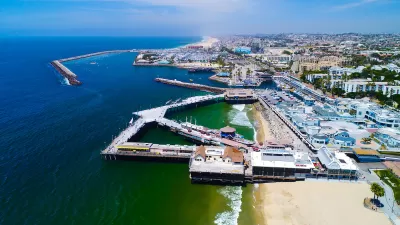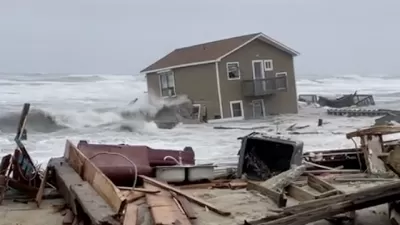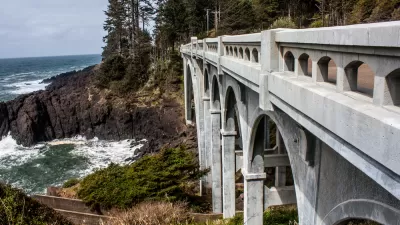In the wake of Hurricane Matthew, a researcher calls attention to the method behind the federal spending on billions of dollars of investment in unsustainable beaches.

Robert S. Young, a professor of coastal geology and director of the Program for the Study of Developed Shorelines at Western Carolina University, takes to the opinion pages of the New York Times to explain the ongoing "beach boondoggle" taking place on the East Coast.
The recent landfall of Hurricane Matthew provides a teachable moment for Young, who notes that the country is responding to the ongoing process of coastal erosion by "trying to hold every shoreline in place forever by pumping sand onto them, largely at federal expense." In fact, a named storm like Hurricane Matthew "can even turn locally funded beach 'nourishment' projects into federally funded ones."
Western Carolina has even created a beach nourishment viewer to illustrate the scale of beach nourishment projects since the early 1990s.
Young argues, however, that the federal funding of beach nourishment is folly. "As sea-level rise continues, and if storms intensify as predicted, the projects will require more sand, and more dollars," he writes. "We are going to run out of both."
While Young acknowledges the arguments in favor of beach nourishment (i.e., "It is true that beach and dune engineering projects benefit local communities. They can protect oceanfront homes and roads while providing a recreational beach for tourists to play on."), he also points out that those benefits are temporary and localized. Moreover, "numerous studies report that the primary beneficiaries of beach stabilization projects are oceanfront property owners."
FULL STORY: The Beach Boondoggle

Maui's Vacation Rental Debate Turns Ugly
Verbal attacks, misinformation campaigns and fistfights plague a high-stakes debate to convert thousands of vacation rentals into long-term housing.

Planetizen Federal Action Tracker
A weekly monitor of how Trump’s orders and actions are impacting planners and planning in America.

In Urban Planning, AI Prompting Could be the New Design Thinking
Creativity has long been key to great urban design. What if we see AI as our new creative partner?

King County Supportive Housing Program Offers Hope for Unhoused Residents
The county is taking a ‘Housing First’ approach that prioritizes getting people into housing, then offering wraparound supportive services.

Researchers Use AI to Get Clearer Picture of US Housing
Analysts are using artificial intelligence to supercharge their research by allowing them to comb through data faster. Though these AI tools can be error prone, they save time and housing researchers are optimistic about the future.

Making Shared Micromobility More Inclusive
Cities and shared mobility system operators can do more to include people with disabilities in planning and operations, per a new report.
Urban Design for Planners 1: Software Tools
This six-course series explores essential urban design concepts using open source software and equips planners with the tools they need to participate fully in the urban design process.
Planning for Universal Design
Learn the tools for implementing Universal Design in planning regulations.
planning NEXT
Appalachian Highlands Housing Partners
Mpact (founded as Rail~Volution)
City of Camden Redevelopment Agency
City of Astoria
City of Portland
City of Laramie





























